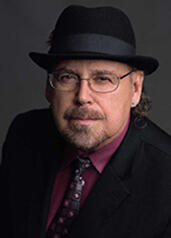 As an historian of religions, Davíd Carrasco, Neil L. Rudenstine Professor for the Study of Latin America, conducts his courses through an ensemble approach, which enables students to learn about complex evidence from a variety of approaches, sources and mediums. This approach contains four parts: (1) using an interdisciplinary intellectual method, (2) incorporating a variety of sources, including artifacts, texts, films, and museum exhibitions; (3) expanding disciplinary perspectives through team teaching and visiting speakers; and (4) organizing diverse student experiences and inviting a range of responses. One example of the ensemble in action is Carrasco’s annual collaboration with the Peabody Museum on their Día de los Muertos exhibition as part of his Gen Ed course, Montezuma’s Mexico: Then and Now (co-taught with William L. Fash) in which students visit and add their own interpretations and art works to the ofrendas.
As an historian of religions, Davíd Carrasco, Neil L. Rudenstine Professor for the Study of Latin America, conducts his courses through an ensemble approach, which enables students to learn about complex evidence from a variety of approaches, sources and mediums. This approach contains four parts: (1) using an interdisciplinary intellectual method, (2) incorporating a variety of sources, including artifacts, texts, films, and museum exhibitions; (3) expanding disciplinary perspectives through team teaching and visiting speakers; and (4) organizing diverse student experiences and inviting a range of responses. One example of the ensemble in action is Carrasco’s annual collaboration with the Peabody Museum on their Día de los Muertos exhibition as part of his Gen Ed course, Montezuma’s Mexico: Then and Now (co-taught with William L. Fash) in which students visit and add their own interpretations and art works to the ofrendas.
Treating merging forms of evidence around us as a collective ensemble
The benefits
Students express appreciation for this collaborative teaching style and the exposure to visiting lecturers. “It appeals to the individual interest of the student, and it’s very amiable to the collection of students and their diverse interests too.” Incorporating information across different types of evidence and mediums helps students “see each other and learn with each other in richer, broader terms. We are an ensemble as well.” Students engage more deeply with the material, the teaching staff, and each other.
"No one approach, no one type of evidence was really sufficient. It isn't a matter of being multidisciplinary—it's a matter of looking at as wide a range of evidence that we can find that human beings themselves have created."
The challenges
Selecting which evidence is included or given more emphasis is difficult. “Even with several professors working from different disciplines you can’t play every instrument in a symphony,” Carrasco notes, “and some instruments don’t play as much.” But it allows students to see both traditional and innovative approaches and generate new questions. COVID-19 also poses challenges. The tactile experiences students have with artifacts at the Peabody Museum have been removed from the syllabi. However, Carrasco offers that “institutions are trying hard to make the adjustment,” with the Peabody Museum and others at Harvard working now to overcome this aspect for the fall. For instance, the Peabody Museum held a widely attended virtual Day of the Dead celebration with presentations by museum staff, faculty, Mexican craftspeople, and student musicians.
Takeaways and best practices
-
Expand the types of evidence offered in your syllabi.
Seek and pull from the variety of sources and mediums that your course content depends on and show deeper respect to what others have made previously with their hands, minds and voices. “[There’s] a wide range of evidence you can find that human beings have created,” Carrasco reflects. Tradition, innovation, and creativity are everywhere, and they can be presented to bring new perspectives, visions, and evidence into a classroom. -
Collaborate with other departments.
Working with other faculty and departments allows for broader perspectives on an issue, creating distinctive opportunities to learn and provides an interdisciplinary lens into course content. “There’s the ensemble of scholars, and then there’s the ensemble of the evidence…and an ensemble of students.” -
Make space for collective growth.
The ensemble approach “allows for more affirmation of the Teaching Fellows. It allows for their interests to emerge and to enlarge and share their approaches.” Because of this, Carrasco notes, “I’ve learned a lot from all these young colleagues.”
Bottom line
This approach can work in any setting, Carrasco stresses. Ultimately, each piece of evidence and concept has been examined from a variety of perspectives outside of one given field. Integrating this complexity into students’ learning journey engages them in the cooperative experience. It helps them see in both focused and rounded perspectives the human and ecological stories they sought when signing up for the course.
